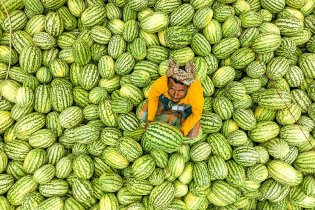中国瓷器源远流长,瓷器是最能代表中国传统文化的一种独特器物。世界早先认识中国也是从“丝绸”和“瓷器”开始的。中国瓷器以青、白、黑、蓝、彩等诸色而闻名与世,青瓷是中国的母瓷之称。

在现实的圈子当中,许多资深行家和资深藏家是不依靠现代科技手段作为鉴定主要依据的,也不看探索中的微观气泡。作为元青花瓷器鉴定,他们只是近距离看胎体受沁、秞面老化痕迹、绘画笔触和是否高修等。毕竟一个完整的元青花价值几百万到千万,大件人物故事类的元青花甚至到几亿。所以,元青花瓷器必须要宏观和微观结合着看,毕竟高仿技术越来越突破我们以往的鉴别经验。

元代景德镇瓶、罐之类器型,采用分段制胎,然后再用胎泥粘合而成,粘接处器表往往突起,给人以不平之感,外壁接痕经打磨,但内壁接痕仍清晰可见,器物颈部内侧略加切削,内壁均不修削,所以在器里的底、腹、口等处胎体接痕表现明显。一般器物的足边不规整,有弯曲现象,说明元代制胎时不讲究修坯,因此显得成型工艺较粗糙。但小型器物也有精致者,胎质显得洁白细腻。削足处理方法常见底足足端外墙斜削一刀,大器足底宽厚多为挖足,挖足有深有浅。器物圈足不十分整齐,呈弯曲状。器底可见螺旋状的切削痕,大瓶、大罐的底部旋削纹较粗、较疏,盘和碗的切削痕较细、较密。

Chinese porcelain has a long history. Porcelain is the most representative of Chinese traditional culture. The world's early understanding of China also began with "silk" and "porcelain". Chinese porcelain is famous for its blue, white, black, blue and color. Celadon is the mother porcelain of China.
In the real circle, many senior experts and collectors do not rely on modern scientific and technological means as the main basis for identification, nor do they look at the micro bubbles in exploration. As the identification of blue and white porcelain of Yuan Dynasty, they only looked at the carcass from a short distance, the traces of aging, painting strokes and whether it was high repair. After all, a complete blue and white painting of the Yuan Dynasty is worth millions to tens of millions, and the blue and white painting of big character stories is even worth hundreds of millions. Therefore, Yuan blue and white porcelain must be combined with macro and micro, after all, high imitation technology is more and more breaking through our previous identification experience.
In Yuan Dynasty, Jingdezhen bottles and cans were made by segmented molding and then bonded with clay. The surface of the bonding part was often protruding, giving people a sense of inequality. The outer wall joint marks were polished, but the inner wall joint marks were still clear. The inner side of the neck was slightly cut, and the inner wall was not trimmed, so the fetal body joint marks in the bottom, abdomen, mouth and other parts of the ware were obvious. The foot edges of common utensils were irregular and curved, which indicated that the shaping process was rough because of not paying attention to trimming in Yuan Dynasty. But there are also exquisite small utensils, the fetus appears white and delicate. The common method of foot cutting is to cut the outer wall of the foot end obliquely. The width and thickness of the big vessel's foot are mostly digging feet, and the digging feet are deep and shallow. The legs of the utensils are not very neat and curved. Spiral cutting marks can be seen at the bottom of the vessel. The spiral cutting marks on the bottom of large bottles and cans are thick and sparse, while the cutting marks on plates and bowls are thin and dense.











